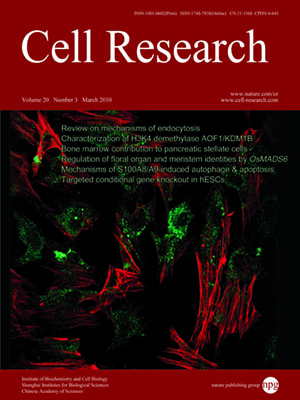
Volume 20, No 3, Mar 2010
ISSN: 1001-0602
EISSN: 1748-7838 2018
impact factor 17.848*
(Clarivate Analytics, 2019)
Volume 20 Issue 3, March 2010: 299-313
ORIGINAL ARTICLES
The AGL6-like gene OsMADS6 regulates floral organ and meristem identities in rice
Haifeng Li1,*, Wanqi Liang1,*, Ruidong Jia2,*, Changsong Yin1, Jie Zong1, Hongzhi Kong2 and Dabing Zhang1,3
1School of Life Science and Biotechnology, Shanghai Jiaotong University, Shanghai 200240, China
2Institute of Botany, Chinese Academy of Sciences, Beijing 100093, China
3Bio-X Research Center, Key Laboratory of Genetics & Development and Neuropsychiatric Diseases, Ministry of Education, Shanghai Jiaotong University, Shanghai 200240, China
Correspondence: Dabing Zhang,(zhangdb@sjtu.edu.cn)
Although AGAMOUS-LIKE6 (AGL6) MADS-box genes are ancient with wide distributions in gymnosperms and angiosperms, their functions remain poorly understood. Here, we show the biological role of the AGL6-like gene, OsMADS6, in specifying floral organ and meristem identities in rice (Oryza sativa L.). OsMADS6 was strongly expressed in the floral meristem at early stages. Subsequently, OsMADS6 transcripts were mainly detectable in paleas, lodicules, carpels and the integument of ovule, as well as in the receptacle. Compared to wild type plants, osmads6 mutants displayed altered palea identity, extra glume-like or mosaic organs, abnormal carpel development and loss of floral meristem determinacy. Strikingly, mutation of a SEPALLATA (SEP)-like gene, OsMADS1 (LHS1), enhanced the defect of osmads6 flowers, and no inner floral organs or glume-like structures were observed in whorls 2 and 3 of osmads1-z osmads6-1 flowers. Furthermore, the osmads1-z osmads6-1 double mutants developed severely indeterminate floral meristems. Our finding, therefore, suggests that the ancient OsMADS6 gene is able to specify “floral state” by determining floral organ and meristem identities in monocot crop rice together with OsMADS1.
Cell Research (2010) 20:299-313. doi: 10.1038/cr.2009.143; published online 29 December 2009
FULL TEXT | PDF
Browse 2180


